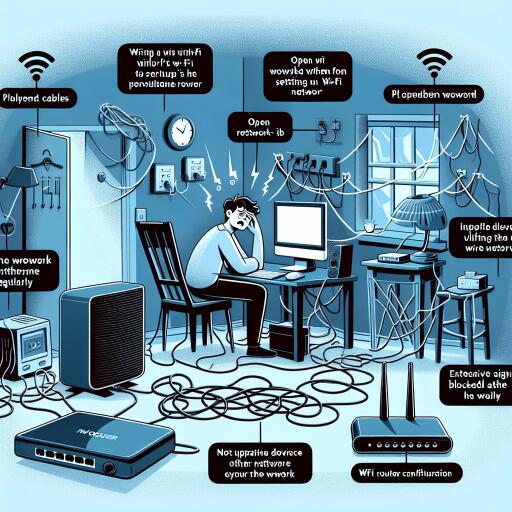10 Mistakes to Avoid When Setting Up a Wi-Fi Network
Setting up a Wi-Fi network that is both secure and high-performing can be straightforward, but only if you avoid the most common pitfalls. Here are ten mistakes to be mindful of during your Wi-Fi setup process:
1. Poor Router Placement
The physical location of your Wi-Fi router significantly impacts your network quality. A common error is placing the router in a closet or a corner, which can lead to weakened signals and reduced coverage. Routers emit signals in all directions, so positioning them centrally and away from physical barriers is key. Ensure antennas are vertically aligned for optimal coverage on the same or one floor above. Angling antennas at 30 degrees can help cover upper and lower floors. Avoid placing routers near large metal objects, which can absorb or reflect signals.
2. Forgetting About Signal Interferences
Signal interference is another crucial factor to consider. Placing your router too close to other electronic devices, especially microwaves, can disrupt your Wi-Fi signal. Microwaves operate on a 2.4GHz frequency, which can interfere with your router’s 2.4GHz signal. Other devices like baby monitors, Bluetooth gadgets, and cordless phones can also cause disruption.
3. Using the Default Router Password
Leaving the router’s default credentials unchanged is a significant security risk. Default passwords are often widely known and easily found online. Malicious actors can use these credentials to infiltrate your network. Change the default username and password immediately after setting up your router.
4. Poorly-Secured Wi-Fi Network
An open or weakly secured Wi-Fi network can be easily exploited. Using a simple or non-existent password is convenient but highly risky. Secure your Wi-Fi with a strong, unique password and an updated encryption protocol. Consider storing this password in a password manager for easy access.
5. Ignoring Router Firmware Updates
Router firmware updates often get overlooked, but they are crucial for maintaining network security and performance. Firmware updates can bring new features, improve performance, and patch vulnerabilities. Always update your router’s firmware to the latest version and enable auto-updates if available.
6. Overlooking Bandwidth Requirements
Each router supports a specific number of devices. Using an entry-level router for numerous devices can lead to slowdowns and disconnections. Assess the number of devices that will connect to your router and choose one that can handle your specific bandwidth needs. Many routers come with “Quality of Service” (QoS) settings that allow you to prioritize traffic to essential devices and services.
7. Not Setting Up a Guest Network
Failing to set up a guest network when hosting visitors can expose your networked devices to unauthorized access. Utilize your router’s built-in features to create a guest network, which isolates guest access from your primary network, protecting devices such as NAS and smart home products.
8. Hiding Network SSID
While hiding your Wi-Fi network’s SSID might seem like a good security measure, it does not significantly deter determined attackers. It’s more effective to secure your network with a strong password using WPA2 Personal (AES) or a newer protocol and avoid other common security mistakes.
9. Using Personal Information in Wi-Fi SSID
Avoid using personal information in your Wi-Fi SSID, as it can be seen by neighbors and anyone near your home. Keeping SSIDs random or generic is the best practice to prevent revealing private information that could be misused.
10. Going Overboard With Access Points or Mesh
While expanding network coverage with multiple access points or mesh nodes is typically a good idea, overdoing it can lead to overlapping signals and interference. Start with a few nodes or access points and add more only if necessary. This approach helps avoid connectivity issues and saves money and installation hassle.
Setting up a Wi-Fi network is simpler than ever, but avoiding common pitfalls is crucial for optimal performance and security. By being aware of and preventing these mistakes, you can establish a reliable and efficient Wi-Fi network at home or in the office. Instead of rushing to buy a new router, consider these tips first to enhance your Wi-Fi experience.









